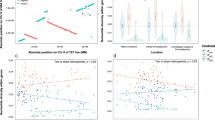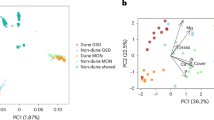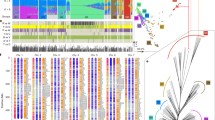Abstract
Two Oregon populations of the partially self-fertilizing Mimulus guttatus, located on Iron Mountain and Cone Peak, were surveyed for the frequency of recessive chlorophyll-deficient lethals by selfing plants collected as seed from the wild. Allelism tests were used to determine the number of different loci with lethal alleles present in the carriers isolated in the population surveys. The frequency of carriers was 0.065 for the Iron Mountain population (23/356) and 0.024 for the Cone Peak population (8/327). Allelism tests of the 31 carriers isolated from both populations revealed the existence of 26 different independently acting loci and two different duplicate locus systems with lethal alleles. These results indicate that the component of inbreeding depression caused by chlorophyll-deficient lethals is not due to single locus heterozygote advantage and is probably caused by mutation-selection balance at many loci. Estimates of the genomic and per locus mutation rates for this class of lethals are in close agreement with those obtained in studies of chlorophyll-deficient lethals in several agricultural plant species. Genetic analysis of a California population of M. guttatus, reported in the literature to exhibit an unusually high per locus mutation rate and segregation distortion for a chlorophyll-deficient lethal, revealed that chlorophyll-deficiency is inherited as a duplicate gene system. This mode of inheritance, not recognized previously, can explain the appearance of unusually high mutation rates and segregation distortion.
Similar content being viewed by others
Article PDF
References
Allendorf, F W. 1976. Amount of polymorphism expected at duplicate loci. Genetics, 83, s1.
Apirion, D, and Zohary, D. 1961. Chlorophyll lethals in natural populations of the orchard grass (Dactylis glomerata L.). A case of balanced polymorphism in plants. Genetics, 46, 393–399.
Bryan, F, and Soltis, D E. 1987. Electrophoretic evidence for allopolyploidy in the fern Polypodium virginianum. Syst Bot, 12, 553–561.
Charlesworth, D, and Charlesworth, B. 1979. The evolutionary genetics of sexual systems in flowering plants. Proc Roy Soc Lond B, 205, 513–530.
Charlesworth, D, and Charlesworth, B. 1987. Inbreeding depression and its evolutionary consequences. Ann Rev Ecol Syst, 18, 237–268.
Charlesworth, D, Morgan, M T, and Charlesworth, B. 1990. Inbreeding depression, genetic load and the evolution of outcrossing rates in a multilocus system with no linkage. Evolution, 44, 1469–1489.
Christiansen, F B, and Frydenberg, O. 1977. Selection-mutation balance for two nonallelic recessives producing an inferior double homozygote. Am J Hum Genet, 29, 195–207.
Clausen, R E, and Cameron, D R. 1950. Inheritance in Nicotiana tabacum: XXIII. Duplicate factors for chlorophyll production. Genetics, 35, 4–10.
Crow, J F. 1964. More on the heterozygous effects of lethals in Drosophila populations. Am Nat, 98, 447–449.
Crow, J F, and Temin, R G. 1964. Evidence for the partial dominance of recessive lethal genes in natural populations of Drosophila. Am Nat, 98, 21–33.
Crow, J F, and Simmons, M J. 1983. The mutation load in Drosophila. In: Ashburner, M, Carson, H. L. and Thompson, J. N. (eds), The Genetics and Biology of Drosophila. Academic Press, London, pp. 1–35.
Crumpacker, D W. 1967. Genetic load in maize (Zea mays L.) and other cross-fertilized plants and animals. Evol Biol, 1, 306–423.
Curran, P L. 1963. Balanced polymorphisms in Dactylis glomerata sub-species woronowii. Nature, 197, 105–106.
Demerec, M. 1923. Inheritance of white seedlings in maize. Genetics, 8, 561–593.
Dobzhansky, T, and Spassky, B. 1968. Genetics of natural populations. XL. Heterotic and deleterious effects of lethals in populations of Drosophila pseudoobscura. Genetics, 59, 411–425.
Dobzhansky, T, and Wright, S. 1941. Genetics of natural populations. V. Relations between mutation rate and accumulation of lethals in populations of Drosophila pseudoobscura. Genetics, 26, 23–51.
Falconer, D S. 1981. Introduction to Quantitative Genetics. 2nd edn. Longman, London.
Ferris, S D, and Whitt, G S. 1977. Loss of duplicate gene expression after polyploidization. Nature, 265, 258–260.
Fisher, R A. 1935. The sheltering of lethals. Am Nat, 69, 446–455.
Ganders, F R. 1972. Heterozygosity for recessive lethals in homosporous fern populations: Thelypteris palustris and Onoclea sensibilis. Bot J Linn Soc, 65, 211–221.
Gastony, G J. 1991. Gene silencing in a polyploid homosporous fern: paleopolyploidy revisited. Proc Natl Acad Sci USA, 88, 1602–1605.
Greenberg, R, and Crow, J F. 1960. A comparison of the effect of lethal and detrimental chromosomes from Drosophila populations. Genetics, 45, 1153–1168.
Gustafsson, A. 1947. The advantageous effect of deleterious mutations. Hereditas, 33, 573–575.
Haldane, J B S. 1933. The part played by recurrent mutation in evolution. Am Nat, 42, 5–19.
Hayes, H K, and Brewbaker, H E. 1924. Frequency of mutations for chlorophyll-deficient seedlings in maize. J Hered, 15, 497–502.
Hedrick, P W. 1987. Genetic load and the mating system in homosporous ferns. Evolution, 41, 1282–1289.
Houle, D. 1989. Allozyme-associated heterosis in Drosophila melanogaster. Genetics, 123, 789–801.
Jinks, J L. 1983. Biometrical genetics of heterosis. In: Frankel, R. (ed.), Heterosis: Reappraisal of Theory and Practice. Springer-Verlag, Berlin, pp. 1–46.
Jørgensen, J H, and Jensen, H P. 1986. The spontaneous chorophyll mutation frequency in Barley. Hereditas, 105, 71–72.
Kiang, Y T. 1970. A natural population of Mimulus guttatus maintaining a high frequency of an albino lethal gene. PhD Dissertation, University of California, Berkeley.
Kiang, Y T. 1972. Pollination study in a natural population of Mimulus guttatus. Evolution, 26, 308–310.
Kiang, Y T, and Libby, W J. 1972. Maintenance of a lethal in a natural population of Mimulus guttatus. Am Nat, 106, 351–367.
Klekowski, E J. 1970. Populational and genetic studies of a homosporous fern, Osmunda regalis. Am J Bot, 57, 1122–1138.
Klekowski, E J. 1976. Genetics of recessive lethality in the fern, Osmunda regalis. J Hered, 67, 146–148.
Klekowski, E J. 1984. Mutational load in clonal plants: a study of two fern species. Evolution, 38, 417–426.
Klekowski, E J. 1988. Mutation, Developmental Selection, and Plant Evolution. Columbia University Press, New York.
Lande, R, and Schemske, D W. 1985. The evolution of self-fertilization and inbreeding depression in plants. I. Genetic models. Evolution, 39, 24–40.
Li, W-H. 1980. Rate of gene silencing at duplicate loci: A theoretical study and interpretation of data from tetraploid fishes. Genetics, 95, 237–258.
Lloyd, D G. 1979. Some reproductive factors affecting the selection of self-fertilization in plants. Am Nat, 113, 67–79.
Lynch, M, and Gabriel, W. 1990. Mutation load and survival of small population. Evolution, 44, 1725–1737.
Maruyama, T, and Takahata, N. 1981. Numerical studies of the frequency trajectories in the process of fixation of null genes at duplicated loci. Heredity, 46, 49–57.
Mather, K, and Jinks, J L. 1982. Biometrical Genetics. Chapman and Hall, London.
Mukai, T, and Burdick, A B. 1959. Single gene heterosis associated with a second chromosome recessive lethal in Drosophila melanogaster. Genetics, 44, 211–232.
Nei, M. 1968. The frequency distribution of lethal chromosomes in finite populations. Proc Natl Acad Sci, USA, 60, 517–524.
Nei, M. 1969. Gene duplication and nucleotide substitution in evolution. Nature, 221, 40–41.
Nei, M, and Roychoudhury, A K. 1973. Probability of fixation of nonfunctional genes at duplicate loci. Am Nat, 107, 362–373.
Ohnishi, O. 1982. Population genetics of cultivated buckwheat, Fagopyrum esculentum Moench. I. Frequency of chlorophyll-deficient mutants in Japanese populations. Japanese. J Genet, 57, 623–639.
Ohno, S. 1972. So much ‘junk’ DNA in our genome, In: Smith, H. H. (ed.), Brookhaven Symposia in Biology No 23. Gordon and Breach, New York, pp. 366–370.
Ohta, T, and Cockerham, C C. 1974. Detrimental genes with partial selfing and effects on a neutral locus. Genet Res, Camb. 23, 191–200.
Prout, T. 1952. Selection against heterozygotes for autosomal lethals in natural populations of Drosophila willistoni. Proc Natl Acad Sci, USA, 38, 478–481.
Riman, L. 1963. A synoptic survey of maize genes. Maydica, 8, 99–123.
Robertson, A, and Narain, P. 1971. The survival of recessive lethals infinite populations. Theor Pop Biol, 2, 24–50.
Schnick, S M, Mukai, T, and Burdick, A B. 1960. Heterozygote viability of a second chromosome recessive lethal in Drosophila melanogaster. Genetics, 45, 315–329.
Schuler, J F. 1954. Natural mutations in inbred lines of maize and their heterotic effect. I. Comparison of parent, mutant and their F1 hybrid in a highly inbred background. Genetics, 39, 908–922.
Simmons, M J, and Crow, J F. 1977. Mutations affecting fitness in Drosophila populations. Ann Rev Genet, 11, 49–78.
Soulé, M. 1986. Conservation Biology. Sinauer Association, Sunderland, MA.
Sprague, G F. 1983. Heterosis in maize: theory and practice. In:Frankel, R. (ed.), Heterosis: Reappraisal of Theory and Practice. Springer-Verlag, Berlin.
Werth, C R, Guttman, S I, and Eshbaugh, W H. 1985. Recurring origins of allopolyploid species in Asplenium. Science, 228, 731–733.
Werth, C R, and Windham, M D. 1991. A model of divergent, allopatric speciation of polyploid Pteridophytes resulting from silencing of duplicate-gene expression. Am Nat, 137, 515–526.
Wettstein, D V, Henningsen, K W, Boynton, J E, Kannagara, G C, and Nielsen, O F. 1971. The genie control of chloroplast development in barley. In:Boardman, N. K. and Smillie, R. M. (eds), Autonomy and Biogenesis of Mitochondria and Chloroplasts. North Holland Press, The Hague, Netherlands, pp. 205–223.
Williams, W, and Brown, A G. 1956. Genetic response to selection in cultivated plants: gene frequencies in Prunus avium. Heredity, 10, 237–245.
Willis, J H. 1991. The role of inbreeding depression in the evolution of two partially self-fertilizing populations of Mimulus guttatus. PhD Dissertation, University of Chicago.
Wright, S. 1937. The distribution of genes in populations. Proc Natl Acad Sci, USA 23, 307–320.
Wright, S. 1969. Evolution and the Genetics of Populations, Vol 2 The Theory of Gene Frequencies. University of Chicago Press, Chicago.
Wright, S. 1977. Evolution and the Genetics of Populations, Vol 3 Experimental Results and Evolutionary Deductions. University of Chicago Press, Chicago.
Wright, S, Dobzhansky, T, and Hovanitz, W. 1942. Genetics of natural populations. VII. The allelism of lethals in the third chromosome of Drosophila pseudoobscura. Genetics, 27, 363–394.
Author information
Authors and Affiliations
Rights and permissions
About this article
Cite this article
Willis, J. Genetic analysis of inbreeding depression caused by chlorophyll-deficient lethals in Mimulus guttatus. Heredity 69, 562–572 (1992). https://doi.org/10.1038/hdy.1992.172
Received:
Issue date:
DOI: https://doi.org/10.1038/hdy.1992.172
Keywords
This article is cited by
-
The genetics of inbreeding depression
Nature Reviews Genetics (2009)
-
Mating systems of diploid and allotetraploid populations of Tragopogon (Asteraceae). I. Natural populations
Heredity (1999)
-
The contribution of male-sterility mutations to inbreeding depression in Mimulus guttatus
Heredity (1999)
-
The cost of selfing inEncyclia cochleata (Orchidaceae)
Plant Systematics and Evolution (1999)
-
Extinction of populations due to inbreeding depression with demographic disturbances
Population Ecology (1997)



